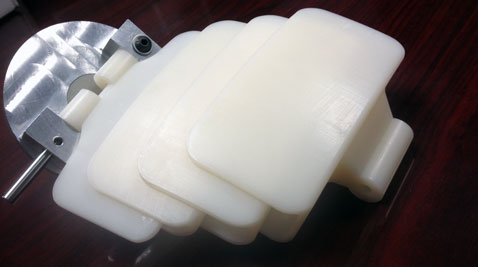
By DANIEL GALLEN
Capital News Service
COLLEGE PARK – A group of University of Maryland engineering students and their professors are awaiting word on their application for a patent on a device they’ve developed that attaches to the back of a football helmet to help cut down on concussions.
The device also attaches to the top of a football player’s shoulder pads to prevent the neck from snapping violently when the athlete is hit. The device’s overlapping plates would be encased in a liquid that would allow the wearer full range of motion in their neck, but on impact, it would harden to stabilize the neck and transfer the force of the collision to the chest, rather than the brain.
The idea is still in the early stages of design and implementation, said Dr. Kenneth Kiger, a professor in the department of mechanical engineering who applied for the patent in February. But if a prototype can be made and serious, on-field testing is successful, some feel the device could have a significant impact on sports concussions.
“If that can restrict the twisting of the head, the rotation of the head, then maybe that could … significantly reduce concussions and all the bad things that occur with concussion,” said Dr. Dennis L. Molfese, scientific director of the Big Ten/CIC-Ivy League Traumatic Brain Injury Collaboration and a professor at the University of Nebraska-Lincoln. “Anything that can reduce the risk should have a profound impact on getting a concussion in the future.”
The central part of the design is the effectiveness of the “shear thickening fluid” encasing the plates in the device. The fluid is a “suspension of very small particulates in a relatively normal liquid,” Kiger said. At rest, the liquid flows normally like water would, but as more pressure is applied, it becomes more difficult to move.
Kiger compared it to a beanbag. When no pressure is applied, the beads inside are loose and are easily moved around. But if someone tries to grab a beanbag with a stiff grip, the beads jam together and the beanbag hardens.
The idea originally came from Dr. Robert E. Fischell of the University of Maryland’s bioengineering department, who has collaborated on the project; students in a bioengineering capstone course built on the idea. Kiger said the capstone didn’t result in the specifics, but he later found the current group of students to work on it partly for course credit and partly as hourly researchers.
They include senior mechanical engineering major Kevin Li, senior bioengineering major Di Wu, senior mechanical engineering major Alek Williams and mechanical engineering Ph.D candidate Dana Ehayei.
The project faces some turnover in the next few weeks, as Li has a job with Accenture lined up after graduation, and Wu and Williams plan on pursuing advanced degrees at Johns Hopkins University and the University of California-Berkeley. If grant money comes in — the group applied to Head Health Challenge II, a contest sponsored by the NFL, Under Armour and GE that could award up to $10 million for new innovations in head safety — Ehayei could return in a post-doctoral position to continue research.
Kiger said the device is “still a hair-brained idea” even with the work the group has put into it since he and Fischell first discussed it in September 2011. The next step is to design the part of the device that will hold the liquid so they can start extended testing on it. Then comes working with athletes to see what works and doesn’t work and any tweaks to the design to make it effective, he said.
“I don’t think we’ll know [how it works] for sure until we start trying it out and seeing what happens putting it on dummies and see how the loads get transferred,” Kiger said. “It’s something you always have to keep in mind whenever you engineer anything that’s meant to be used as a safety device.”
Kiger and his group have their eyes on the end result. They realize the impact a device such as this one could have on football fans all over the country — and on the athletes. Super Bowl XLVIII in February drew a record 111.5 million viewers. But the league still faces challenges, including a concussions lawsuit filed by former players, who allege the league withheld information about the longterm effects of concussions and are seeking damages.
Kiger said he doesn’t see the device making a splash at the upper reaches of the game right away. Instead, he thinks it would make its way into the lower levels, and then players would grow up with it being part of the game.
“I think there’s a market for it for sure,” Williams said. “I know I played a couple years of football in high school, and my parents were really worried about me. I’m sure they would — I’m not sure how much they would pay — but they would definitely look into buying something that would help protect my brain. It’s the most important asset.”


You must be logged in to post a comment.